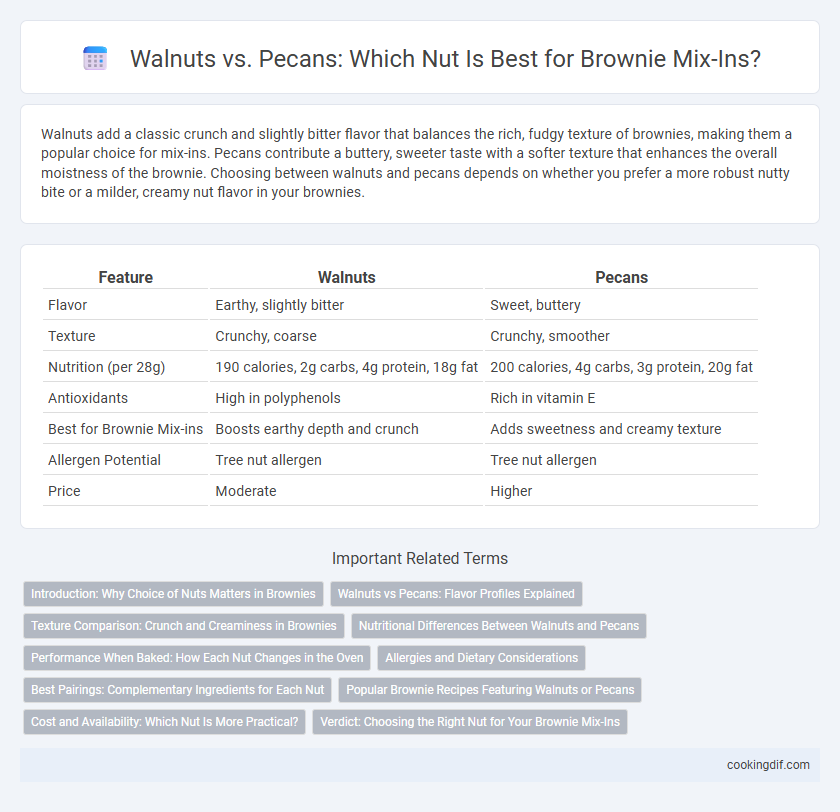Walnuts add a classic crunch and slightly bitter flavor that balances the rich, fudgy texture of brownies, making them a popular choice for mix-ins. Pecans contribute a buttery, sweeter taste with a softer texture that enhances the overall moistness of the brownie. Choosing between walnuts and pecans depends on whether you prefer a more robust nutty bite or a milder, creamy nut flavor in your brownies.
Table of Comparison
| Feature | Walnuts | Pecans |
|---|---|---|
| Flavor | Earthy, slightly bitter | Sweet, buttery |
| Texture | Crunchy, coarse | Crunchy, smoother |
| Nutrition (per 28g) | 190 calories, 2g carbs, 4g protein, 18g fat | 200 calories, 4g carbs, 3g protein, 20g fat |
| Antioxidants | High in polyphenols | Rich in vitamin E |
| Best for Brownie Mix-ins | Boosts earthy depth and crunch | Adds sweetness and creamy texture |
| Allergen Potential | Tree nut allergen | Tree nut allergen |
| Price | Moderate | Higher |
Introduction: Why Choice of Nuts Matters in Brownies
Choosing between walnuts and pecans as mix-ins significantly impacts the texture and flavor profile of brownies, influencing the overall eating experience. Walnuts provide a robust, slightly bitter taste that contrasts with the sweetness of the chocolate, while pecans offer a sweeter, buttery flavor that enhances richness. The nut choice also affects nutritional content, with walnuts delivering more omega-3 fatty acids and pecans offering higher levels of antioxidants.
Walnuts vs Pecans: Flavor Profiles Explained
Walnuts provide a slightly bitter, earthy flavor with a crunchy texture that complements the rich, fudgy taste of brownies, enhancing their overall depth. Pecans offer a sweeter, buttery taste with a tender crunch, adding a smooth and slightly caramelized note to the brownie mix-in. The choice between walnuts and pecans depends on the desired balance of bitterness versus sweetness and texture preference in the final brownie.
Texture Comparison: Crunch and Creaminess in Brownies
Walnuts provide a robust crunch that contrasts with the fudgy texture of brownies, enhancing each bite with a slightly bitter, earthy flavor. Pecans offer a softer, buttery crunch that blends more seamlessly with the creamy, dense brownie base, delivering a smoother texture overall. Choosing between walnuts and pecans depends on whether you prefer a pronounced crunch or a creamier mouthfeel in your brownie experience.
Nutritional Differences Between Walnuts and Pecans
Walnuts contain higher levels of omega-3 fatty acids and antioxidants compared to pecans, making them a heart-healthy option for brownie mix-ins. Pecans offer more monounsaturated fats and slightly more fiber, which supports digestion and cholesterol management. Incorporating either nut into brownies boosts protein and essential minerals such as magnesium and zinc, but walnuts provide a greater anti-inflammatory benefit.
Performance When Baked: How Each Nut Changes in the Oven
Walnuts develop a slightly bitter, robust flavor and soften moderately when baked in brownies, complementing the rich chocolate without overpowering it. Pecans retain more of their natural sweetness and tend to stay crunchier, adding a pleasant texture contrast with a buttery, toasted note. Both nuts enhance moisture retention differently: walnuts absorb more fat and cause a denser crumb, while pecans keep the brownie lighter and more crumbly.
Allergies and Dietary Considerations
Walnuts and pecans are popular mix-ins for brownies but differ significantly in allergy risks and dietary considerations. Walnuts are one of the top eight tree nuts that frequently trigger allergic reactions, affecting approximately 1-2% of the population, whereas pecans, though also a tree nut, tend to cause fewer allergic responses but still require caution for nut-allergic individuals. For those following specific diets, walnuts offer higher omega-3 fatty acids beneficial for heart health, while pecans provide more monounsaturated fats and antioxidants, making the choice dependent on allergy safety and nutritional goals.
Best Pairings: Complementary Ingredients for Each Nut
Walnuts enhance brownie mix-ins with a rich, slightly bitter flavor that complements the deep chocolate taste, pairing perfectly with ingredients like dark chocolate chunks and espresso powder. Pecans offer a sweeter, buttery profile, making them ideal alongside caramel swirls and sea salt for a balanced, indulgent bite. Both nuts provide a satisfying crunch but cater to different flavor preferences--walnuts for a robust, earthy contrast and pecans for a smooth, nutty sweetness.
Popular Brownie Recipes Featuring Walnuts or Pecans
Walnuts add a rich, slightly bitter crunch to brownies, commonly featured in classic recipes like the traditional fudgy walnut brownie and chocolate walnut torte. Pecans offer a buttery, sweet flavor that complements recipes such as pecan praline brownies and caramel pecan brownies, enhancing both texture and taste. Popular brownie recipes often highlight these nuts to balance sweetness and provide a satisfying contrast within each bite.
Cost and Availability: Which Nut Is More Practical?
Walnuts are generally more cost-effective and widely available in most grocery stores year-round, making them a practical choice for brownie mix-ins. Pecans tend to be pricier and may be less accessible depending on the region and season due to their more limited growing areas. Choosing walnuts not only reduces expenses but also ensures consistent supply for baking needs.
Verdict: Choosing the Right Nut for Your Brownie Mix-Ins
Walnuts provide a classic, slightly bitter crunch that complements the rich, fudgy texture of brownies, enhancing flavor with their earthy undertones. Pecans offer a sweeter, buttery profile and a softer crunch, adding a unique depth and subtle caramel notes to the mix-in. Choosing between walnuts and pecans depends on whether you prefer a traditional nutty contrast or a richer, sweeter nuance in your brownie bites.
Walnuts vs pecans for brownie mix-ins Infographic

 cookingdif.com
cookingdif.com